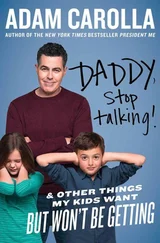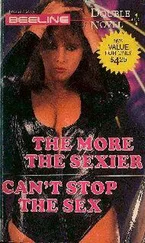“Try to think of happy things,” he says, caressing my forehead.
I stare at the ceiling, tears welling. What happy things? Who could be happy in a world of podiums and microphones?
“There are a billion people in China who don’t give a rat’s ass about your speech,” Ken offers sympathetically.
This helps, for approximately five seconds. I turn over and watch the alarm clock. Finally it’s six thirty. At least the worst part, the night-before part, is over; this time tomorrow, I’ll be free. But first I have to get through today. I dress grimly and put on a coat. Ken hands me a sports water bottle filled with Baileys Irish Cream. I’m not a big drinker, but I like Baileys because it tastes like a chocolate milkshake. “Drink this fifteen minutes before you go on,” he says, kissing me good-bye.
I take the elevator downstairs and settle into the car that waits to ferry me to my destination, a big corporate headquarters in suburban New Jersey. The drive gives me plenty of time to wonder how I allowed myself to get into this situation. I recently left my job as a Wall Street lawyer to start my own consulting firm. Mostly I’ve worked one-on-one or in small groups, which feels comfortable. But when an acquaintance who is general counsel at a big media company asked me to run a seminar for his entire executive team, I agreed—enthusiastically, even!—for reasons I can’t fathom now. I find myself praying for calamity—a flood or a small earthquake, maybe—anything so I don’t have to go through with this. Then I feel guilty for involving the rest of the city in my drama.
The car pulls up at the client’s office and I step out, trying to project the peppy self-assurance of a successful consultant. The event organizer escorts me to the auditorium. I ask for directions to the bathroom, and, in the privacy of the stall, gulp from the water bottle. For a few moments I stand still, waiting for the alcohol to work its magic. But nothing happens—I’m still terrified. Maybe I should take another swig. No, it’s only nine in the morning—what if they smell the liquor on my breath? I reapply my lipstick and make my way back to the event room, where I arrange my notecards at the podium as the room fills with important-looking businesspeople. Whatever you do, try not to vomit , I tell myself.
Some of the executives glance up at me, but most of them stare fixedly at their BlackBerrys. Clearly, I’m taking them away from very pressing work. How am I going to hold their attention long enough for them to stop pounding out urgent communiqués into their tiny typewriters? I vow, right then and there, that I will never make another speech.
* * *
Well, since then I’ve given plenty of them. I haven’t completely overcome my anxiety, but over the years I’ve discovered strategies that can help anyone with stage fright who needs to speak in public. More about that in chapter 5.
In the meantime, I’ve told you my tale of abject terror because it lies at the heart of some of my most urgent questions about introversion. On some deep level, my fear of public speaking seems connected to other aspects of my personality that I appreciate, especially my love of all things gentle and cerebral. This strikes me as a not-uncommon constellation of traits. But are they truly connected, and if so, how? Are they the result of “nurture”—the way I was raised? Both of my parents are soft-spoken, reflective types; my mother hates public speaking too. Or are they my “nature”—something deep in my genetic makeup?
I’ve been puzzling over these questions for my entire adult life. Fortunately, so have researchers at Harvard, where scientists are probing the human brain in an attempt to discover the biological origins of human temperament.
One such scientist is an eighty-two-year-old man named Jerome Kagan, one of the great developmental psychologists of the twentieth century. Kagan devoted his career to studying the emotional and cognitive development of children. In a series of groundbreaking longitudinal studies, he followed children from infancy through adolescence, documenting their physiologies and personalities along the way. Longitudinal studies like these are time-consuming, expensive, and therefore rare—but when they pay off, as Kagan’s did, they pay off big.
For one of those studies, launched in 1989 and still ongoing, Professor Kagan and his team gathered five hundred four-month-old infants in his Laboratory for Child Development at Harvard, predicting they’d be able to tell, on the strength of a forty-five-minute evaluation, which babies were more likely to turn into introverts or extroverts. If you’ve seen a four-month-old baby lately, this may seem an audacious claim. But Kagan had been studying temperament for a long time, and he had a theory.
Kagan and his team exposed the four-month-olds to a carefully chosen set of new experiences. The infants heard tape-recorded voices and balloons popping, saw colorful mobiles dance before their eyes, and inhaled the scent of alcohol on cotton swabs. They had wildly varying reactions to the new stimuli. About 20 percent cried lustily and pumped their arms and legs. Kagan called this group “high-reactive.” About 40 percent stayed quiet and placid, moving their arms or legs occasionally, but without all the dramatic limb-pumping. This group Kagan called “low-reactive.” The remaining 40 percent fell between these two extremes. In a startlingly counterintuitive hypothesis, Kagan predicted that it was the infants in the high-reactive group—the lusty arm-pumpers—who were most likely to grow into quiet teenagers.
When they were two, four, seven, and eleven years old, many of the children returned to Kagan’s lab for follow-up testing of their reactions to new people and events. At the age of two, the children met a lady wearing a gas mask and a lab coat, a man dressed in a clown costume, and a radio-controlled robot. At seven, they were asked to play with kids they’d never met before. At eleven, an unfamiliar adult interviewed them about their personal lives. Kagan’s team observed how the children reacted to these strange situations, noting their body language and recording how often and spontaneously they laughed, talked, and smiled. They also interviewed the kids and their parents about what the children were like outside the laboratory. Did they prefer one or two close friends to a merry band? Did they like visiting new places? Were they risk-takers or were they more cautious? Did they consider themselves shy or bold?
Many of the children turned out exactly as Kagan had expected. The high-reactive infants, the 20 percent who’d hollered at the mobiles bobbing above their heads, were more likely to have developed serious, careful personalities. The low-reactive infants—the quiet ones—were more likely to have become relaxed and confident types. High and low reactivity tended to correspond, in other words, to introversion and extroversion. As Kagan mused in his 1998 book, Galen’s Prophecy , “Carl Jung’s descriptions of the introvert and extrovert, written over seventy-five years ago, apply with uncanny accuracy to a proportion of our high- and low-reactive adolescents.”
Kagan describes two of those adolescents—reserved Tom and extroverted Ralph—and the differences between the two are striking. Tom, who was unusually shy as a child, is good at school, watchful and quiet, devoted to his girlfriend and parents, prone to worry, and loves learning on his own and thinking about intellectual problems. He plans to be a scientist. “Like … other famous introverts who were shy children,” writes Kagan, comparing Tom to T. S. Eliot and the mathematician-philosopher Alfred North Whitehead, Tom “has chosen a life of the mind.”
Ralph, in contrast, is relaxed and self-assured. He engages the interviewer from Kagan’s team as a peer, not as an authority figure twenty-five years his senior. Though Ralph is very bright, he recently failed his English and science classes because he’d been goofing around. But nothing much bothers Ralph. He admits his flaws cheerfully.
Читать дальше
![Сьюзан Кейн Quiet [The Power of Introverts in a World That Can't Stop Talking] обложка книги](/books/33084/syuzan-kejn-quiet-the-power-of-introverts-in-a-wo-cover.webp)











